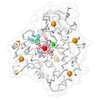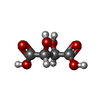[English] 日本語
 Yorodumi
Yorodumi- PDB-4a4l: CRYSTAL STRUCTURE OF POLO-LIKE KINASE 1 IN COMPLEX WITH A 5-(2-AM... -
+ Open data
Open data
- Basic information
Basic information
| Entry | Database: PDB / ID: 4a4l | ||||||
|---|---|---|---|---|---|---|---|
| Title | CRYSTAL STRUCTURE OF POLO-LIKE KINASE 1 IN COMPLEX WITH A 5-(2-AMINO- PYRIMIDIN-4-YL)-1H-PYRROLE INHIBITOR | ||||||
 Components Components | SERINE/THREONINE-PROTEIN KINASE PLK1 | ||||||
 Keywords Keywords |  TRANSFERASE TRANSFERASE | ||||||
| Function / homology |  Function and homology information Function and homology informationMitotic Telophase/Cytokinesis / regulation of protein localization to cell cortex / Mitotic Metaphase/Anaphase Transition / Golgi inheritance / synaptonemal complex disassembly / mitotic nuclear membrane disassembly / Activation of NIMA Kinases NEK9, NEK6, NEK7 / homologous chromosome segregation / protein localization to nuclear envelope /  polo kinase ...Mitotic Telophase/Cytokinesis / regulation of protein localization to cell cortex / Mitotic Metaphase/Anaphase Transition / Golgi inheritance / synaptonemal complex disassembly / mitotic nuclear membrane disassembly / Activation of NIMA Kinases NEK9, NEK6, NEK7 / homologous chromosome segregation / protein localization to nuclear envelope / polo kinase ...Mitotic Telophase/Cytokinesis / regulation of protein localization to cell cortex / Mitotic Metaphase/Anaphase Transition / Golgi inheritance / synaptonemal complex disassembly / mitotic nuclear membrane disassembly / Activation of NIMA Kinases NEK9, NEK6, NEK7 / homologous chromosome segregation / protein localization to nuclear envelope /  polo kinase / nuclear membrane disassembly / Phosphorylation of Emi1 / metaphase/anaphase transition of mitotic cell cycle / polo kinase / nuclear membrane disassembly / Phosphorylation of Emi1 / metaphase/anaphase transition of mitotic cell cycle /  synaptonemal complex / female meiosis chromosome segregation / outer kinetochore / Phosphorylation of the APC/C / synaptonemal complex / female meiosis chromosome segregation / outer kinetochore / Phosphorylation of the APC/C /  anaphase-promoting complex binding / anaphase-promoting complex binding /  regulation of protein binding / double-strand break repair via alternative nonhomologous end joining / negative regulation of cyclin-dependent protein serine/threonine kinase activity / positive regulation of ubiquitin protein ligase activity / regulation of protein binding / double-strand break repair via alternative nonhomologous end joining / negative regulation of cyclin-dependent protein serine/threonine kinase activity / positive regulation of ubiquitin protein ligase activity /  regulation of mitotic spindle assembly / microtubule bundle formation / Polo-like kinase mediated events / mitotic chromosome condensation / Golgi Cisternae Pericentriolar Stack Reorganization / positive regulation of ubiquitin-protein transferase activity / sister chromatid cohesion / regulation of mitotic metaphase/anaphase transition / regulation of mitotic spindle assembly / microtubule bundle formation / Polo-like kinase mediated events / mitotic chromosome condensation / Golgi Cisternae Pericentriolar Stack Reorganization / positive regulation of ubiquitin-protein transferase activity / sister chromatid cohesion / regulation of mitotic metaphase/anaphase transition /  centrosome cycle / regulation of mitotic cell cycle phase transition / mitotic spindle assembly checkpoint signaling / mitotic spindle pole / regulation of mitotic cell cycle / regulation of anaphase-promoting complex-dependent catabolic process / mitotic sister chromatid segregation / mitotic G2 DNA damage checkpoint signaling / positive regulation of proteolysis / establishment of mitotic spindle orientation / mitotic cytokinesis / centriolar satellite / spindle midzone / Amplification of signal from unattached kinetochores via a MAD2 inhibitory signal / Cyclin A/B1/B2 associated events during G2/M transition / Mitotic Prometaphase / EML4 and NUDC in mitotic spindle formation / Loss of Nlp from mitotic centrosomes / Loss of proteins required for interphase microtubule organization from the centrosome / Recruitment of mitotic centrosome proteins and complexes / protein localization to chromatin / Resolution of Sister Chromatid Cohesion / Recruitment of NuMA to mitotic centrosomes / Anchoring of the basal body to the plasma membrane / centrosome cycle / regulation of mitotic cell cycle phase transition / mitotic spindle assembly checkpoint signaling / mitotic spindle pole / regulation of mitotic cell cycle / regulation of anaphase-promoting complex-dependent catabolic process / mitotic sister chromatid segregation / mitotic G2 DNA damage checkpoint signaling / positive regulation of proteolysis / establishment of mitotic spindle orientation / mitotic cytokinesis / centriolar satellite / spindle midzone / Amplification of signal from unattached kinetochores via a MAD2 inhibitory signal / Cyclin A/B1/B2 associated events during G2/M transition / Mitotic Prometaphase / EML4 and NUDC in mitotic spindle formation / Loss of Nlp from mitotic centrosomes / Loss of proteins required for interphase microtubule organization from the centrosome / Recruitment of mitotic centrosome proteins and complexes / protein localization to chromatin / Resolution of Sister Chromatid Cohesion / Recruitment of NuMA to mitotic centrosomes / Anchoring of the basal body to the plasma membrane /  centriole / AURKA Activation by TPX2 / mitotic spindle organization / Condensation of Prophase Chromosomes / positive regulation of peptidyl-threonine phosphorylation / centriole / AURKA Activation by TPX2 / mitotic spindle organization / Condensation of Prophase Chromosomes / positive regulation of peptidyl-threonine phosphorylation /  regulation of cytokinesis / RHO GTPases Activate Formins / protein destabilization / APC/C:Cdh1 mediated degradation of Cdc20 and other APC/C:Cdh1 targeted proteins in late mitosis/early G1 / establishment of protein localization / spindle / regulation of cytokinesis / RHO GTPases Activate Formins / protein destabilization / APC/C:Cdh1 mediated degradation of Cdc20 and other APC/C:Cdh1 targeted proteins in late mitosis/early G1 / establishment of protein localization / spindle /  kinetochore / kinetochore /  spindle pole / positive regulation of protein localization to nucleus / Separation of Sister Chromatids / The role of GTSE1 in G2/M progression after G2 checkpoint / microtubule cytoskeleton / G2/M transition of mitotic cell cycle / double-strand break repair / spindle pole / positive regulation of protein localization to nucleus / Separation of Sister Chromatids / The role of GTSE1 in G2/M progression after G2 checkpoint / microtubule cytoskeleton / G2/M transition of mitotic cell cycle / double-strand break repair /  Regulation of PLK1 Activity at G2/M Transition / positive regulation of proteasomal ubiquitin-dependent protein catabolic process / mitotic cell cycle / midbody / Regulation of PLK1 Activity at G2/M Transition / positive regulation of proteasomal ubiquitin-dependent protein catabolic process / mitotic cell cycle / midbody /  microtubule binding / peptidyl-serine phosphorylation / protein ubiquitination / microtubule binding / peptidyl-serine phosphorylation / protein ubiquitination /  regulation of cell cycle / regulation of cell cycle /  protein kinase activity / protein kinase activity /  protein phosphorylation / protein serine kinase activity / protein phosphorylation / protein serine kinase activity /  centrosome / protein serine/threonine kinase activity / centrosome / protein serine/threonine kinase activity /  chromatin / negative regulation of apoptotic process / chromatin / negative regulation of apoptotic process /  protein kinase binding / negative regulation of transcription by RNA polymerase II / magnesium ion binding / protein kinase binding / negative regulation of transcription by RNA polymerase II / magnesium ion binding /  nucleoplasm / nucleoplasm /  ATP binding / identical protein binding / ATP binding / identical protein binding /  nucleus / nucleus /  cytosol / cytosol /  cytoplasm cytoplasmSimilarity search - Function | ||||||
| Biological species |   HOMO SAPIENS (human) HOMO SAPIENS (human) | ||||||
| Method |  X-RAY DIFFRACTION / X-RAY DIFFRACTION /  SYNCHROTRON / SYNCHROTRON /  MOLECULAR REPLACEMENT / Resolution: 2.35 Å MOLECULAR REPLACEMENT / Resolution: 2.35 Å | ||||||
 Authors Authors | Bertrand, J.A. / Bossi, R.T. | ||||||
 Citation Citation |  Journal: Bioorg.Med.Chem.Lett. / Year: 2012 Journal: Bioorg.Med.Chem.Lett. / Year: 2012Title: 5-(2-Amino-Pyrimidin-4-Yl)-1H-Pyrrole and 2-(2-Amino-Pyrimidin-4-Yl)-1,5,6,7-Tetrahydro-Pyrrolo[3,2-C]Pyridin-4-One Derivatives as New Classes of Selective and Orally Available Polo-Like Kinase 1 Inhibitors. Authors: Caruso, M. / Valsasina, B. / Ballinari, D. / Bertrand, J.A. / Brasca, M.G. / Caldarelli, M. / Cappella, P. / Fiorentini, F. / Gianellini, L.M. / Scolaro, A. / Beria, I. | ||||||
| History |
|
- Structure visualization
Structure visualization
| Structure viewer | Molecule:  Molmil Molmil Jmol/JSmol Jmol/JSmol |
|---|
- Downloads & links
Downloads & links
- Download
Download
| PDBx/mmCIF format |  4a4l.cif.gz 4a4l.cif.gz | 71.4 KB | Display |  PDBx/mmCIF format PDBx/mmCIF format |
|---|---|---|---|---|
| PDB format |  pdb4a4l.ent.gz pdb4a4l.ent.gz | 56.3 KB | Display |  PDB format PDB format |
| PDBx/mmJSON format |  4a4l.json.gz 4a4l.json.gz | Tree view |  PDBx/mmJSON format PDBx/mmJSON format | |
| Others |  Other downloads Other downloads |
-Validation report
| Arichive directory |  https://data.pdbj.org/pub/pdb/validation_reports/a4/4a4l https://data.pdbj.org/pub/pdb/validation_reports/a4/4a4l ftp://data.pdbj.org/pub/pdb/validation_reports/a4/4a4l ftp://data.pdbj.org/pub/pdb/validation_reports/a4/4a4l | HTTPS FTP |
|---|
-Related structure data
- Links
Links
- Assembly
Assembly
| Deposited unit | 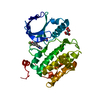
| ||||||||
|---|---|---|---|---|---|---|---|---|---|
| 1 | 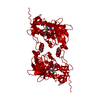
| ||||||||
| Unit cell |
|
- Components
Components
| #1: Protein | Mass: 35646.531 Da / Num. of mol.: 1 / Fragment: KINASE DOMAIN, RESIDUES 36-345 Source method: isolated from a genetically manipulated source Source: (gene. exp.)   HOMO SAPIENS (human) / Cell line (production host): High Five / Production host: HOMO SAPIENS (human) / Cell line (production host): High Five / Production host:   SPODOPTERA FRUGIPERDA (fall armyworm) / References: UniProt: P53350, SPODOPTERA FRUGIPERDA (fall armyworm) / References: UniProt: P53350,  polo kinase polo kinase |
|---|---|
| #2: Chemical | ChemComp-ZN / |
| #3: Chemical | ChemComp-TLA /  Tartaric acid Tartaric acid |
| #4: Chemical | ChemComp-939 / |
| #5: Water | ChemComp-HOH /  Water Water |
-Experimental details
-Experiment
| Experiment | Method:  X-RAY DIFFRACTION / Number of used crystals: 1 X-RAY DIFFRACTION / Number of used crystals: 1 |
|---|
- Sample preparation
Sample preparation
| Crystal | Density Matthews: 2.8 Å3/Da / Density % sol: 56.1 % / Description: NONE |
|---|---|
Crystal grow | Temperature: 277 K / Method: vapor diffusion, sitting drop / pH: 6 Details: 1.2 M NA/K TARTRATE, 25 MM ZN ACETATE, 0.10 M MES PH 6.0, VAPOR DIFFUSION, SITTING DROP, TEMPERATURE 277 K |
-Data collection
| Diffraction | Mean temperature: 100 K |
|---|---|
| Diffraction source | Source:  SYNCHROTRON / Site: SYNCHROTRON / Site:  ESRF ESRF  / Beamline: ID14-3 / Wavelength: 0.931 / Beamline: ID14-3 / Wavelength: 0.931 |
| Detector | Type: ADSC CCD / Detector: CCD / Date: May 5, 2007 |
| Radiation | Protocol: SINGLE WAVELENGTH / Monochromatic (M) / Laue (L): M / Scattering type: x-ray |
| Radiation wavelength | Wavelength : 0.931 Å / Relative weight: 1 : 0.931 Å / Relative weight: 1 |
| Reflection | Resolution: 2.35→57.35 Å / Num. obs: 16356 / % possible obs: 95.9 % / Observed criterion σ(I): 0 / Redundancy: 2.3 % / Biso Wilson estimate: 26.9 Å2 / Rmerge(I) obs: 0.08 / Net I/σ(I): 9.4 |
| Reflection shell | Resolution: 2.35→2.48 Å / Redundancy: 2.1 % / Rmerge(I) obs: 0.44 / Mean I/σ(I) obs: 2 / % possible all: 78.9 |
- Processing
Processing
| Software |
| ||||||||||||||||||||||||||||||||||||||||||||||||||||||||||||||||||||||||||||||||
|---|---|---|---|---|---|---|---|---|---|---|---|---|---|---|---|---|---|---|---|---|---|---|---|---|---|---|---|---|---|---|---|---|---|---|---|---|---|---|---|---|---|---|---|---|---|---|---|---|---|---|---|---|---|---|---|---|---|---|---|---|---|---|---|---|---|---|---|---|---|---|---|---|---|---|---|---|---|---|---|---|---|
| Refinement | Method to determine structure : :  MOLECULAR REPLACEMENT MOLECULAR REPLACEMENTStarting model: INTERNAL STRUCTURE WITH AMP-PNP Resolution: 2.35→28.84 Å / Rfactor Rfree error: 0.01 / Data cutoff high absF: 1698701.39 / Data cutoff low absF: 0 / Isotropic thermal model: RESTRAINED / Cross valid method: THROUGHOUT / σ(F): 0
| ||||||||||||||||||||||||||||||||||||||||||||||||||||||||||||||||||||||||||||||||
| Solvent computation | Solvent model: FLAT MODEL / Bsol: 47.7489 Å2 / ksol: 0.390391 e/Å3 | ||||||||||||||||||||||||||||||||||||||||||||||||||||||||||||||||||||||||||||||||
| Displacement parameters | Biso mean: 42.4 Å2
| ||||||||||||||||||||||||||||||||||||||||||||||||||||||||||||||||||||||||||||||||
| Refine analyze |
| ||||||||||||||||||||||||||||||||||||||||||||||||||||||||||||||||||||||||||||||||
| Refinement step | Cycle: LAST / Resolution: 2.35→28.84 Å
| ||||||||||||||||||||||||||||||||||||||||||||||||||||||||||||||||||||||||||||||||
| Refine LS restraints |
| ||||||||||||||||||||||||||||||||||||||||||||||||||||||||||||||||||||||||||||||||
| Refine LS restraints NCS | NCS model details: NONE | ||||||||||||||||||||||||||||||||||||||||||||||||||||||||||||||||||||||||||||||||
| LS refinement shell | Resolution: 2.35→2.5 Å / Rfactor Rfree error: 0.036 / Total num. of bins used: 6
| ||||||||||||||||||||||||||||||||||||||||||||||||||||||||||||||||||||||||||||||||
| Xplor file |
|
 Movie
Movie Controller
Controller









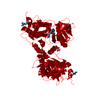
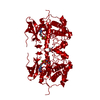
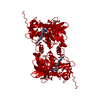
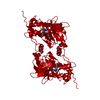


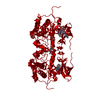

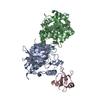
 PDBj
PDBj






